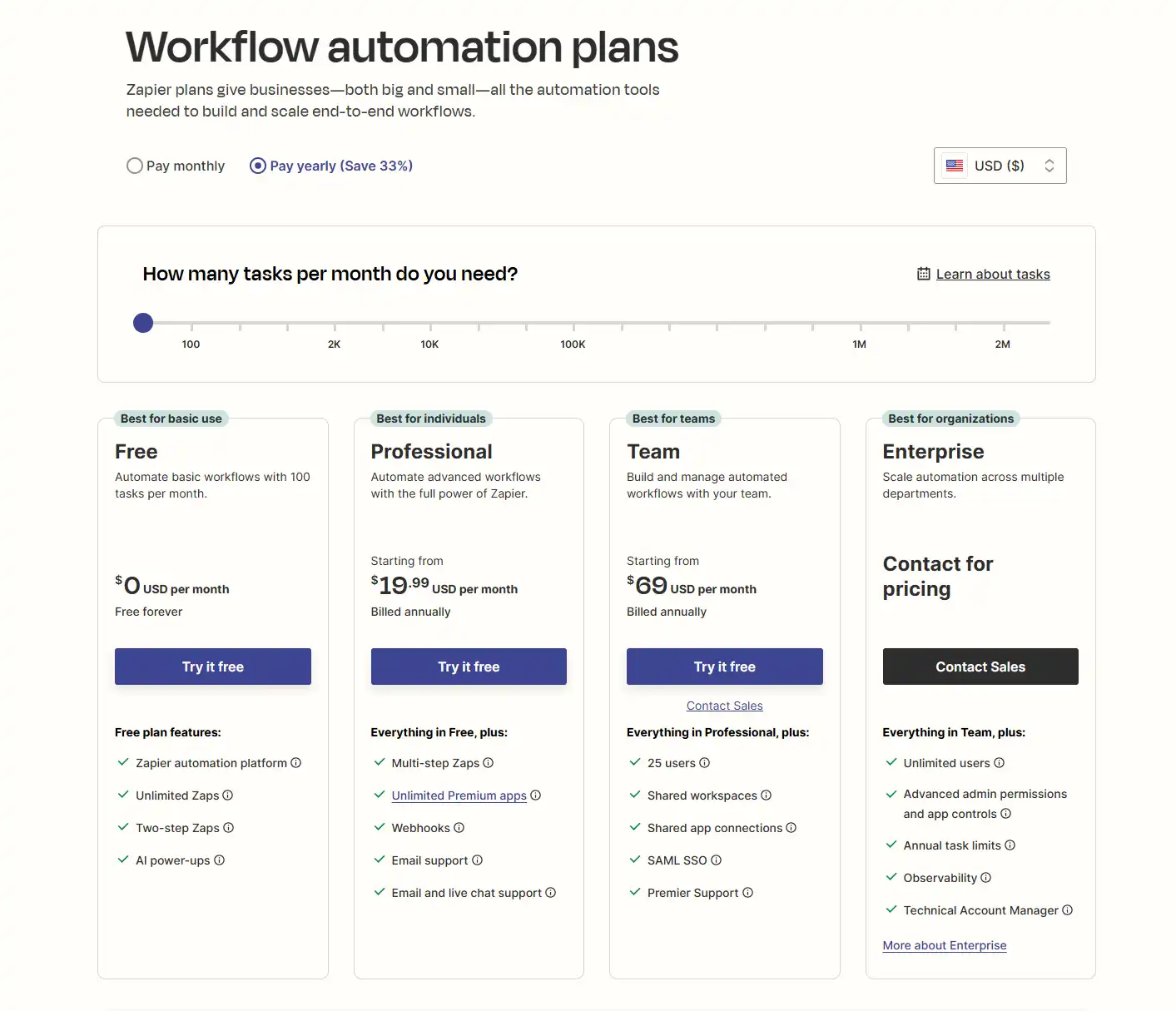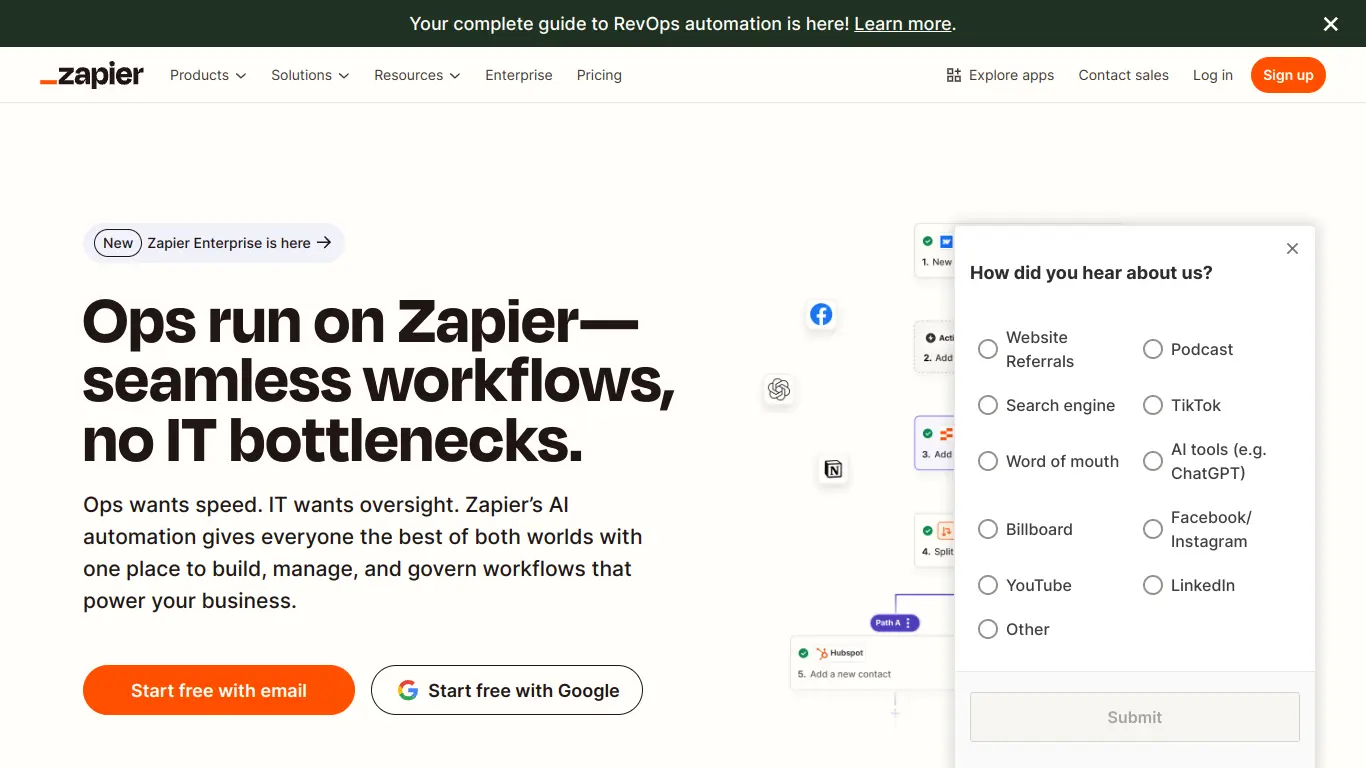Zapier connects your apps and automates workflows. Save time and work smarter with this leading no-code automation platform.
Businesses and individuals alike are constantly juggling multiple apps and platforms to get work done. Ever found yourself manually copying data from one app to another, wasting precious time on repetitive tasks? Or maybe you’ve dreamed of connecting your favorite tools to work together seamlessly, but lacked the technical skills to make it happen? I’ve been there too, and it’s incredibly frustrating when you know there must be a better way.
Enter Zapier – a powerful automation platform designed to be the bridge between your digital tools. If you’ve been looking for a way to streamline your workflows, save time, and eliminate mundane tasks, you’re in the right place. Let’s dive into what makes Zapier one of the most valuable productivity tools on the market today.
Introduction to Zapier
What is Zapier and its Purpose?
Zapier (pronounced “zappier”) is a web-based automation tool that connects your favorite apps and services together. Founded in 2011, it acts as a middleman between over 5,000 apps, allowing them to communicate and work together without requiring any coding knowledge.
At its core, Zapier’s purpose is simple yet transformative: to automate the repetitive tasks that consume your workday. It operates on a trigger-action system, where an event in one app automatically causes an action in another app. For example, when you receive an email with an attachment (trigger), Zapier can automatically save that attachment to your Dropbox (action).
These automated workflows are called “Zaps,” and they’re the building blocks of the Zapier ecosystem. Each Zap consists of a trigger and one or more actions, creating a chain reaction that handles routine tasks without your intervention.
Who is Zapier Designed For?
Zapier’s beauty lies in its accessibility and versatility. It’s designed for:
- Small business owners who need to automate routine operations without hiring developers
- Marketing professionals looking to streamline campaigns across multiple platforms
- Sales teams wanting to synchronize customer data between CRM and other tools
- Customer support specialists aiming to centralize communication channels
- Freelancers juggling multiple clients and platforms
- Project managers coordinating workflows across various tools
- Non-technical users who want the benefits of automation without coding skills
- IT professionals seeking to create integrations more quickly than custom development
Whether you’re a solopreneur or part of a large organization, if you find yourself repeatedly transferring data between apps or performing the same sequences of actions, Zapier was built with you in mind.
Getting Started with Zapier: How to Use It
Getting started with Zapier is refreshingly straightforward:
- Create an account: Visit Zapier.com and sign up for a free account.
- Connect your apps: Authorize Zapier to access the applications you want to connect. This is done through secure OAuth connections that don’t require sharing your passwords.
- Choose a template or create a Zap: You can either select from thousands of pre-built templates or create your own custom Zap.
- Set up your trigger: Select the app where your workflow should begin and define the specific event that will trigger your Zap.
- Configure your action(s): Choose what should happen when your trigger occurs. You can add multiple actions for complex workflows.
- Test and activate: Zapier allows you to test each step before activating your Zap to ensure everything works correctly.
The platform offers an intuitive editor with clear instructions throughout the setup process. For most common integrations, you can be up and running in less than five minutes without writing a single line of code.
Zapier’s Key Features and Benefits
Core Functionalities of Zapier
Zapier’s functionality extends far beyond simple connections between apps. Here are the core features that power its automation capabilities:
1. Multi-Step Zaps
Create complex workflows with multiple actions triggered by a single event. For example, when you receive a new lead form submission, you can add the contact to your CRM, send a welcome email, notify your sales team via Slack, and create a follow-up task – all automatically.
2. Filters
Add conditional logic to your Zaps to ensure actions only occur when specific criteria are met. For instance, only send high-priority notifications for deals above a certain value.
3. Formatters
Transform your data between steps with built-in tools for text formatting, date manipulation, number calculations, and more – no coding required.
4. Paths
Create branching workflows that take different actions based on conditions. This allows for sophisticated decision trees within your automations.
5. Delay Step
Schedule actions to occur after a specific time interval, perfect for follow-up sequences or spaced communications.
6. Search Steps
Find existing records in your apps before creating new ones to prevent duplicates and maintain data integrity.
7. Custom Webhooks
Connect to virtually any web service, even those not officially supported as Zapier apps.
8. App Integration Platform
With over 5,000 app integrations, Zapier connects with almost every major business tool and platform available.
Advantages of Using Zapier
The benefits of incorporating Zapier into your workflow extend beyond simple time savings:
🕒 Time Efficiency
According to Zapier’s internal research, users save an average of 10 hours per week by automating routine tasks. That’s over 500 hours per year that can be redirected to high-value work.
💰 Cost Reduction
Instead of hiring developers to build custom integrations or additional staff to handle manual processes, Zapier provides an affordable alternative that scales with your needs.
🛠️ No Technical Expertise Required
The visual, no-code interface empowers anyone to create powerful automations regardless of technical background.
🚀 Increased Productivity
By eliminating repetitive tasks, teams can focus on creative and strategic work that drives business growth.
🔄 Improved Data Consistency
Automated data transfer between systems eliminates human error and ensures information remains synchronized across all platforms.
⚡ Rapid Implementation
Most Zaps can be set up in minutes, providing immediate ROI compared to custom integration projects that might take weeks or months.
🔌 Flexibility and Scalability
As your business grows and processes evolve, Zapier workflows can be quickly modified to adapt to changing needs.
Main Use Cases and Applications
Zapier’s versatility makes it valuable across virtually every department and industry. Here are some popular applications:
Marketing Automation:
- Automatically add webinar registrants to email marketing campaigns
- Sync leads between advertising platforms and CRM systems
- Post content across multiple social media channels simultaneously
- Create tasks for content production when editorial calendars update
Sales Process Optimization:
- Create contacts in your CRM from lead form submissions
- Send personalized follow-up emails when prospects take specific actions
- Alert sales representatives of high-priority leads via SMS or Slack
- Update deal stages across platforms when status changes
Customer Support Enhancement:
- Create support tickets from customer emails or form submissions
- Route conversations to appropriate team members based on content
- Send customer satisfaction surveys after ticket resolution
- Log support interactions in your CRM for complete customer profiles
HR and Recruitment:
- Add new job applicants to candidate tracking systems
- Schedule interviews when candidates meet specific criteria
- Create onboarding tasks when new employees are hired
- Collect and organize employee feedback from surveys
Finance and Accounting:
- Create invoices from approved project milestones
- Send payment reminders for overdue accounts
- Log expenses from receipt emails to accounting software
- Generate financial reports on a scheduled basis
Project Management:
- Create project tasks from client requests or form submissions
- Notify team members when deadlines approach
- Update project status across multiple tools simultaneously
- Archive completed project assets to storage platforms
Exploring Zapier’s Platform and Interface
User Interface and User Experience
Zapier’s interface strikes an impressive balance between power and simplicity. The platform has evolved significantly since its launch, with continuous refinements to make advanced automation accessible to everyone.
The main dashboard provides a clear overview of your active Zaps, recent activity, and recommended templates based on your connected apps. The Zap editor features a visual, step-by-step process that guides users through workflow creation:
- Trigger selection with helpful suggestions based on popularity and your existing apps
- Account connection with secure OAuth integration
- Trigger configuration with clear field explanations
- Action setup with intelligent field mapping from your trigger data
- Testing tools to verify each step works correctly
For advanced users, Zapier offers powerful features like:
- Folders for organizing related Zaps
- Team collaboration tools for sharing and managing Zaps across departments
- Version history to track changes to your workflows
- Detailed logs showing exactly how data moves through your Zaps
The interface is responsive and works well on both desktop and mobile devices, though complex Zap creation is easier on larger screens.
Platform Accessibility
Zapier prioritizes accessibility across multiple dimensions:
Device Compatibility:
Zapier works on all major operating systems and browsers. While there’s no dedicated mobile app, the responsive web interface functions well on smartphones and tablets for monitoring and basic management.
Language Support:
The platform is primarily available in English, though it can process data in virtually any language that your connected apps support.
Accessibility Standards:
Zapier’s interface adheres to modern web accessibility guidelines with proper contrast, keyboard navigation support, and screen reader compatibility.
Learning Resources:
The platform offers extensive documentation, tutorials, and learning resources suitable for various learning styles:
- A comprehensive help center with searchable articles
- Step-by-step tutorials for common workflows
- Video guides for visual learners
- An active community forum for peer support
- Regular webinars for more complex use cases
Support Options:
Support accessibility varies by plan, with free users accessing self-service resources while paid plans include email support. Premium plans offer faster response times and dedicated support channels.
Zapier Pricing and Plans
Subscription Options
Zapier offers tiered pricing to accommodate different needs, from individual users to large enterprises. Current plans include:

For most small businesses and professionals, the Starter or Professional plan provides the best balance of features and affordability. Teams working collaboratively benefit from the Team plan’s shared workspace and permissions controls.
Zapier occasionally offers free trials of premium features and discounts for annual billing, making it worth checking their current promotions when signing up.
Zapier Reviews and User Feedback
Pros and Cons of Zapier
Based on aggregated user feedback across major review platforms, here’s a balanced assessment of Zapier’s strengths and limitations:
Pros:
✅ Vast App Ecosystem: With 5,000+ integrations, Zapier connects almost every major business tool.
✅ No-Code Accessibility: Users consistently praise how easy it is to create powerful automations without technical expertise.
✅ Reliability: The platform maintains excellent uptime and dependability for business-critical workflows.
✅ Time Savings: Users frequently report saving 5-20 hours per week on manual tasks.
✅ Excellent Documentation: Comprehensive guides and tutorials make learning the platform straightforward.
✅ Regular Updates: New features and app integrations are continually added.
✅ Responsive Support: Paid plans receive knowledgeable and helpful customer service.
Cons:
❌ Price Scaling: Costs can increase significantly as task usage grows, making it expensive for high-volume users.
❌ Update Frequency Limitations: The 15-minute delay on lower tiers can be problematic for time-sensitive workflows.
❌ Learning Curve for Advanced Features: While basic Zaps are easy to create, mastering filters, paths, and formatters requires investment in learning.
❌ Limited Data Transformation: Complex data manipulation sometimes requires workarounds or additional steps.
❌ Debugging Challenges: When Zaps fail, identifying the exact issue can sometimes be difficult.
❌ Mobile Experience: No dedicated app and the complex editor works better on desktop.
User Testimonials and Opinions
Here’s what real users are saying about their experience with Zapier:
“Zapier has transformed how our marketing team operates. We’ve automated lead capture across five different platforms, saving at least 15 hours weekly and ensuring no prospect falls through the cracks.” – Sarah T., Digital Marketing Director
“As a solopreneur, Zapier is like having a virtual assistant. It handles all my repetitive tasks between Gmail, Trello, and my CRM, letting me focus on client work instead of administrative busywork.” – Marcus L., Independent Consultant
“The ROI is undeniable. We calculated that our Zapier workflows save our company approximately $45,000 annually in labor costs that would otherwise go to manual data entry and transfers.” – Jennifer K., Operations Manager
“While I love Zapier overall, task limits can be frustrating. We had to upgrade twice as our automation needs grew, significantly increasing our costs.” – David R., Small Business Owner
“The learning curve was steeper than expected for some of our team members, but Zapier’s documentation and support helped tremendously. Now that we’re up and running, we couldn’t imagine working without it.” – Michael T., IT Administrator
Across major review platforms, Zapier consistently maintains ratings between 4.5-4.8 out of 5 stars, with particularly high marks for ease of use, feature set, and customer support.
Zapier Company and Background Information
About the Company Behind Zapier
Zapier’s origin story reflects the problem it aims to solve. Founded in 2011 by Wade Foster, Bryan Helmig, and Mike Knoop, the company began as a side project at a startup weekend in Columbia, Missouri. The founders were frustrated by the lack of integration between the growing number of web applications businesses relied on.
From the beginning, Zapier made two distinctive choices that shaped its culture and operations:
- Remote-First Philosophy: Zapier embraced a fully distributed workforce before it was common, allowing them to hire talent globally. Today, the company has over 500 employees working across 38 countries and maintains no central headquarters.
- Bootstrapped Growth: Unlike many tech startups, Zapier didn’t follow the typical venture capital path initially. The company was largely bootstrapped until 2021, focusing on sustainable growth rather than the “grow at all costs” mentality common in Silicon Valley.
In January 2021, Zapier received its first major investment – a $5 billion valuation led by Sequoia Capital and Steadfast Financial, marking one of the largest investments ever in a remote-first company.
The company’s commitment to both users and employees has earned it recognition including:
- Inc. 5000 List: Ranked among America’s fastest-growing private companies multiple years
- Forbes Cloud 100: Listed among the world’s top private cloud companies
- Glassdoor Best Places to Work: Recognized for employee satisfaction
- G2 Leader: Consistently rated as a leader in iPaaS (Integration Platform as a Service)
Zapier’s mission remains “to make automation work for everyone,” with a continued focus on democratizing automation tools previously accessible only to large enterprises or technical specialists.
Zapier Alternatives and Competitors
Top Zapier Alternatives in the Market
While Zapier pioneered mainstream automation, several strong alternatives have emerged, each with distinct advantages:
1. Make (formerly Integromat)
Make offers a more visual workflow builder with an attractive interface that displays your automation as a flowchart. It’s known for more flexible pricing based on operations rather than tasks, potentially making it more cost-effective for certain use cases.
2. Automate.io
A simpler alternative with a focus on ease of use, Automate.io offers competitive pricing for basic automation needs. While it has fewer integrations than Zapier, its core offerings cover most popular business applications.
3. Microsoft Power Automate
Formerly Flow, this platform excels for organizations already invested in the Microsoft ecosystem. It offers deep integration with Office 365 and Microsoft’s business applications, plus robotic process automation (RPA) capabilities for desktop applications.
4. IFTTT (If This Then That)
Originally consumer-focused, IFTTT offers simple “applet” workflows. While less robust for complex business processes, it excels with IoT, smart home, and personal productivity automations.
5. Tray.io
Targeting enterprise users, Tray.io provides more sophisticated data mapping, transformations, and enterprise-grade security for complex integration needs.
6. n8n
An open-source option for organizations wanting self-hosted automation. It offers flexibility and privacy control, though requires more technical expertise to implement.
Zapier vs. Competitors: A Comparative Analysis
Here’s how Zapier stacks up against its main competitors across key dimensions:
| Feature | Zapier | Make | Automate.io | Power Automate | IFTTT |
|---|---|---|---|---|---|
| App Integrations | 5,000+ | 1,000+ | 200+ | 700+ | 700+ |
| Pricing Structure | Per task | Per operation | Per task | Per user/flow | Per applet |
| Free Plan | 5 Zaps, 100 tasks | 1,000 ops/month | 5 bots, 300 actions | Limited flows | 3 applets |
| Enterprise Features | ⭐⭐⭐ | ⭐⭐⭐⭐ | ⭐⭐ | ⭐⭐⭐⭐⭐ | ⭐⭐ |
| Ease of Use | ⭐⭐⭐⭐⭐ | ⭐⭐⭐ | ⭐⭐⭐⭐⭐ | ⭐⭐⭐ | ⭐⭐⭐⭐⭐ |
| Advanced Workflows | ⭐⭐⭐⭐ | ⭐⭐⭐⭐⭐ | ⭐⭐⭐ | ⭐⭐⭐⭐ | ⭐⭐ |
| Execution Speed | 1-15 min | Nearly real-time | 5-15 min | Varies | 15 min |
| Data Transformation | ⭐⭐⭐⭐ | ⭐⭐⭐⭐⭐ | ⭐⭐⭐ | ⭐⭐⭐⭐ | ⭐⭐ |
| Self-Hosting Option | No | No | No | Yes (limited) | No |
When to Choose Zapier:
- You need the broadest range of app integrations
- Ease of use is a priority for non-technical users
- You want battle-tested reliability for business-critical processes
- Extensive documentation and community support are important
When to Consider Alternatives:
- Make: For more complex, visual workflows with data-heavy operations
- Power Automate: For Microsoft-centric organizations needing desktop automation
- Automate.io: For simpler needs with more budget-friendly pricing
- IFTTT: For personal/IoT automations with simpler requirements
- Tray.io: For enterprise-grade data transformation and security
- n8n: For organizations requiring self-hosted solution and data sovereignty
Zapier Website Traffic and Analytics
Website Visit Over Time
Zapier’s web traffic demonstrates the growing popularity of automation tools. According to data from SimilarWeb and other traffic analysis platforms:
- Monthly Visits: Zapier.com receives approximately 12-15 million monthly visits
- Growth Trend: Traffic has shown consistent year-over-year growth of 15-20%
- Page Views: Average 5-6 page views per session, indicating engaged visitors
- Visit Duration: Average session duration of 4-5 minutes
Traffic spikes typically coincide with major platform updates, new integration announcements, and industry events where Zapier presents. The COVID-19 pandemic also accelerated adoption as remote work increased demand for automation tools.
Geographical Distribution of Users
Zapier’s user base spans globally, with traffic distribution approximately:
- 🇺🇸 United States: 45%
- 🇬🇧 United Kingdom: 8%
- 🇨🇦 Canada: 6%
- 🇦🇺 Australia: 5%
- 🇩🇪 Germany: 4%
- 🇮🇳 India: 4%
- 🇫🇷 France: 3%
- 🇧🇷 Brazil: 2%
- 🇯🇵 Japan: 2%
- Other countries: 21%
This distribution reflects Zapier’s strong presence in English-speaking markets while showing growing adoption in other regions, particularly in Europe and Asia.
Main Traffic Sources
Zapier’s traffic acquisition comes from diverse channels:
- Organic Search: 55% – Dominated by automation-related keywords, integration searches, and app connection queries
- Direct Traffic: 20% – Indicating strong brand recognition and returning users
- Referral Traffic: 15% – Largely from integration partners, app marketplaces, and software directories
- Social Media: 5% – Primarily from Twitter, LinkedIn, and YouTube
- Paid Search: 3% – Targeted campaigns for specific integration use cases
- Email: 2% – From newsletters and user communications
The high proportion of organic search traffic demonstrates Zapier’s strong SEO presence and content marketing strategy, which includes extensive documentation, tutorials, and use case examples for various integrations.
Frequently Asked Questions about Zapier (FAQs)
General Questions about Zapier
Q: What exactly is Zapier?
A: Zapier is an online automation tool that connects your apps and services. You can connect two or more apps to automate repetitive tasks without coding or relying on developers to build the integration.
Q: How do you pronounce Zapier?
A: Zapier is pronounced “zap-ee-er,” like “happier” with a Z. Their tagline “Zapier makes you happier” helps people remember.
Q: Is Zapier safe and secure?
A: Yes, Zapier implements strong security measures including data encryption, regular security audits, and compliance with GDPR, CCPA, and SOC 2 Type II standards. They don’t store your data longer than needed to process your Zaps.
Q: Does Zapier work with my country/language?
A: Zapier works globally with no geographic restrictions. While the interface is in English, it can process data in any language your connected apps support.
Feature Specific Questions
Q: How many apps can Zapier connect?
A: Zapier currently integrates with over 5,000 apps and services, with new ones added regularly.
Q: What’s the difference between a trigger and an action?
A: A trigger is the event that starts a Zap (like receiving an email or a new form submission). An action is what happens after the trigger (like adding a row to a spreadsheet or sending a notification).
Q: Can Zapier transfer files between apps?
A: Yes, Zapier can transfer files between supported apps, though there’s a 100MB file size limit on most plans.
Q: How fast does Zapier check for new triggers?
A: The checking frequency depends on your plan. Free and Starter plans check every 15 minutes, Professional every 2 minutes, and Team/Company plans every 1 minute.
Q: Can I create complex conditional workflows?
A: Yes, with paid plans you can use Filters to add conditions and Paths to create branching workflows based on different criteria.
Pricing and Subscription FAQs
Q: What counts as a “task” in Zapier’s pricing?
A: A task is counted each time Zapier completes an action within your Zap. For multi-step Zaps, each action counts as a separate task.
Q: What happens if I exceed my monthly task limit?
A: Zapier will notify you when you’re approaching your limit. If you exceed it, your Zaps will pause until the next billing cycle or until you upgrade your plan.
Q: Can I change plans or cancel anytime?
A: Yes, you can upgrade, downgrade, or cancel your subscription at any time. Plan changes take effect immediately, while refunds follow Zapier’s refund policy.
Q: Does Zapier offer discounts?
A: Zapier offers discounts for annual billing (typically 20% off) and special pricing for nonprofits and educational institutions.
Support and Help FAQs
Q: How can I get help with setting up a Zap?
A: Zapier offers multiple support options:
- Extensive help documentation at help.zapier.com
- Email support (response times vary by plan)
- Community forums for peer assistance
- Live chat support on higher-tier plans
Q: What should I do if my Zap isn’t working?
A: Zapier provides a built-in Zap editor testing tool to identify issues. You can also check your Zap History to see detailed logs of attempts and errors. The Task History shows exactly what data was processed and where failures occurred.
Q: Can Zapier build custom integrations?
A: For standard apps, you can build your own integrations using Zapier’s platform. For unique needs, Zapier’s developer platform allows creating private integrations. Enterprise customers may receive assistance with complex integration requirements.
Conclusion: Is Zapier Worth It?
Summary of Zapier’s Strengths and Weaknesses
After thoroughly examining Zapier’s features, pricing, and user experiences, here’s a balanced assessment of its value proposition:
Key Strengths:
- Unmatched App Ecosystem: With 5,000+ integrations, Zapier offers the most comprehensive connection options in the automation market.
- Accessibility for Non-Technical Users: The intuitive interface makes powerful automation accessible without coding skills, democratizing tools previously available only to developers.
- Time-Saving Potential: Users consistently report saving 5-20 hours weekly on manual tasks, translating to significant productivity gains and ROI.
- Reliability and Stability: As a mature platform with over a decade of development, Zapier delivers enterprise-grade dependability for business-critical processes.
- Extensive Documentation and Community: The robust knowledge base, active user community, and support resources reduce implementation barriers.
Notable Limitations:
- Cost Scaling: As automation needs grow, costs can increase substantially, especially for high-volume users or complex multi-step workflows.
- Update Frequency Caps: The 15-minute trigger delay on lower-tier plans may be insufficient for time-sensitive processes.
- Learning Curve for Advanced Features: While basic automation is straightforward, mastering complex workflows requires investment in learning the platform’s nuances.
- Data Transformation Constraints: Some complex data manipulations require workarounds or multiple steps compared to more developer-focused alternatives.
Final Recommendation and Verdict
Zapier delivers exceptional value for:
✅ Small to medium businesses seeking to eliminate repetitive tasks without technical resources
✅ Marketing and sales teams needing to synchronize data across multiple platforms
✅ Customer service operations aiming to streamline communication workflows
✅ Freelancers and solopreneurs juggling multiple tools and platforms
✅ Operations teams looking to reduce manual data entry and transfer
The ROI calculation typically favors Zapier when:
- Manual tasks are consuming significant employee time
- Data accuracy issues occur due to human error in transfers
- Workflows require timely but not real-time synchronization
- The organization uses many different cloud applications
- IT resources for custom integration development are limited
Zapier may be less ideal for:
- Enterprise-scale data processing requiring millisecond response times
- Organizations with extremely high automation volume on tight budgets
- Workflows involving primarily desktop applications rather than web services
- Scenarios requiring complex data transformations as the primary function
The Final Verdict: Zapier continues to lead the automation market for good reason. For most businesses and professionals dealing with the challenges of disconnected SaaS tools, Zapier offers the most accessible, comprehensive, and reliable solution available. While pricing requires consideration as usage scales, the productivity gains and error reduction typically outweigh the costs.
Start with the free plan to test specific workflows relevant to your needs, and you’ll quickly determine whether Zapier deserves a permanent place in your technology stack. For most users who take the time to implement it thoughtfully, Zapier doesn’t just connect apps – it transforms how work gets done.




















